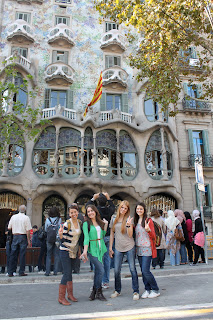 |
| Nasjonalgalleriet |
One of our first stops was the Nasjonalgalleriet (National Gallery). The gallery had particular emphasis on National Romanticism and Impressionism, which was convenient because those were the styles we are currently studying. Surprisingly there were quite a few recognizable pieces.
 |
| The Scream |
The most popular painting that gets the most recognition is The Scream By: Edward Munch. This painting was a breakthrough for expressionism. Supposedly it was stolen from the gallery in 2004 and then found and returned in 2006.
By accident we came to a sculpture that was made and dedicated to the Olympics that were held in Lilehammer, Norway. It appeared to be a metal replica of the Olympic torch.
 |
| Slottet |
We walked up to Slottet, the Royal Palace of Norway. Seeing this palace and comparing it to the ones in Great Britain, I realized that Norwegian architecture is much more simple, classical, and clean. The palace was up a on a hill overlooking the city centre. Norway is similar to Great Britain; the country has a constitutional monarchy. King Harold V and the royal family live in the palace year round.
We got to the palace right in time to see the changing of the guards-, which I didn’t even know, happened in Norway. The palace guard was much more friendly than all of the guards in England. He was kind enough to let us take pictures with him.
 |
| Stortinget |
I thought that Stortinget, the Norwegian Parliament building, was the most beautiful in architecture. The style is a blend of Norwegian and Italian building traditions.
 |
| Nobel Peace Center |
One of the coolest parts of our time in Norway was seeing the Nobel Peace Center. Oslo’s old railway station, Uestbanen, houses the Nobel Peace Center. The Center is not a museum, but rather a place that presents the work of past and present Nobel Peace Prize winners and to provide a forum for discussion on the topics of war, peace, and resolution of conflict. It had rich and varied exhibitions that were well designed for interaction and involvement. One of the exhibits had you try and help a young girl in an immigration colony in Congo. I also learned a great deal about Alfred Nobel and the reasons for each past and present Peace Prize awarded. I had no idea that Barrack Obama had won the Nobel Peace Prize in 2009 “for his extraordinary efforts to strengthen international diplomacy between peoples and for his promotion for nuclear nonproliferation.” He was the fourth president of the United States to be awarded a Nobel Peace Prize.
 |
| Aker Brygge |
Aker Brygge is a long established shipyard that has been transformed to provide a major shopping and entertainment centre with residential apartments and the city’s biggest concentration of restaurants. We walked along the coastline and watched a few Fjord ships come in and large Yachts go out. We also had a lovely lunch at one of the restaurants. It was one of my favorite harbors that I have ever seen.
 |
| Oslo Opera House |
Our last stop before we left Oslo was going to see the recently (2008) built Norwegian opera house. It is the home of the Norwegian National Opera and Ballet. It sits right on the waterfront at Bjorvika, and reminds me of the Sydney, Australia Opera House because of its slopping roof and brilliant design.












































